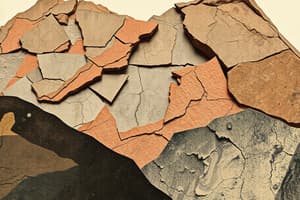Podcast
Questions and Answers
What is a metamorphic rock?
What is a metamorphic rock?
A metamorphic rock is a rock whose original form and/or mineralogy has been changed, through pressure and/or temperature changes.
What are the two major types of texture in metamorphic rocks?
What are the two major types of texture in metamorphic rocks?
- Granular rocks
- Foliated rocks (correct)
- Nonfoliated rocks (correct)
- Igneous rocks
How can foliation be recognized?
How can foliation be recognized?
Foliation can manifest as a visible alignment of minerals or a tendency for the rock to break along planes.
Describe progressive metamorphism in metamorphic rocks.
Describe progressive metamorphism in metamorphic rocks.
Describe the low grade metamorphic rocks.
Describe the low grade metamorphic rocks.
Describe the medium to high grade metamorphic rocks.
Describe the medium to high grade metamorphic rocks.
Describe the nonfoliated metamorphic rocks.
Describe the nonfoliated metamorphic rocks.
Flashcards are hidden until you start studying
Study Notes
Metamorphic Rocks Overview
- Metamorphic rocks originate from preexisting rocks, known as parent rocks or protoliths, altered by temperature and pressure changes below Earth's surface.
Types of Metamorphic Texture
- Foliated rocks exhibit a preferred alignment of platy minerals, whereas nonfoliated (granular) rocks lack this alignment, often indicating an absence of platy minerals.
Recognizing Foliation
- Foliation can appear as visible mineral alignment or microscopic alignment that leads rocks to break along specific planes due to the weakness created by the aligned minerals.
Progressive Metamorphism
- Foliated rocks are classified by metamorphic grade:
- Low-grade examples: Slate and phyllite, formed under low temperature and pressure.
- High-grade examples: Schist and gneiss, formed under high temperature and pressure.
Low-Grade Metamorphic Rocks
- Slate: Composed of clay minerals from shale; transformed into mica minerals that align and cause the rock to break along these planes.
- Phyllite: Contains micas larger than those in slate, imparting a sheen; also breaks parallel to aligned micas.
Medium to High-Grade Metamorphic Rocks
- Schist: Contains visible aligned micas; common minerals include biotite, muscovite, chlorite, and garnet; may feature porphyroblasts—large crystals embedded in the rock.
- Gneiss: Distinguished by coarse-grained minerals arranged in parallel, discontinuous light and dark bands, ranging from 1 to several centimeters thick.
Nonfoliated Metamorphic Rocks
- Composed of coarse-grained minerals that do not exhibit alignment.
- Marble: Derived from limestone, typically white to pink; identified by its inability to scratch glass.
- Quartzite: Originates from quartz sandstone, can also be white to pink; harder than marble, able to scratch glass.
Studying That Suits You
Use AI to generate personalized quizzes and flashcards to suit your learning preferences.




